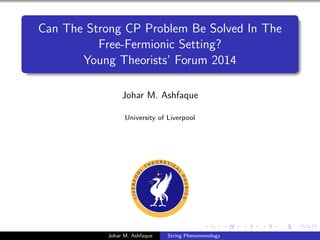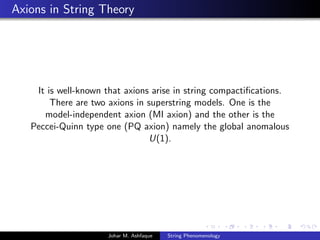YTF 2014 - JM ASHFAQUE
- 1. Can The Strong CP Problem Be Solved In The Free-Fermionic Setting? Young Theorists¡¯ Forum 2014 Johar M. Ashfaque University of Liverpool Johar M. Ashfaque String Phenomenology
- 2. What Is The Strong CP Problem? The SU(3) gauge theory allows a CPV interaction term of the form LCP = ¦È¦Ás 32¦Ð2 ?G?¦ÍG?¦Í to be added to the QCD Lagrangian which contributes to the neutron electric dipole moment (nEDM). Note. ¦È ¡Ô ¦È0 + ¦Èweak with ¦È0 being the angle given above the electroweak scale and ¦Èweak is the value introduced by the electroweak CP violation. Johar M. Ashfaque String Phenomenology
- 3. What Is The Strong CP Problem? The current bound on the nEDM is |dN| < 2.9 ¡Á 10?26 e cm so that |¦È| < 10?10 rad which is a strikingly small value for a dimensionless natural constant given that the CP violating phase, ¦È, in the CKM mixing matrix is of order one. This smallness of ¦È despite the large amount of CP violation in the weak sector is known as the strong CP problem. Johar M. Ashfaque String Phenomenology
- 4. Solutions To The Strong CP Problem Axions are important because they are the most promising solution to the Strong CP problem. Other solutions are ruled out or disfavoured by phenomenology: Calculable ¦È - The Nelson-Barr Mechanism (mimics CKM-type CP violation) Up Quark Mass Vanishing - Weinberg¡¯s famous up-down quark mass ratio Z = mu md = 5 9 Johar M. Ashfaque String Phenomenology
- 5. What Are Axions? Axions are the quanta of the axion ?eld, a(x), which is the phase of the PQ complex scalar ?eld after the spontaneously breaking of the PQ symmetry gives it an absolute value fa. Simply put axions are pseudo-Nambu-Goldstone bosons related to the spontaneous breaking of the anomalous U(1) global symmetry. Johar M. Ashfaque String Phenomenology
- 6. Axions in String Theory It is well-known that axions arise in string compacti?cations. There are two axions in superstring models. One is the model-independent axion (MI axion) and the other is the Peccei-Quinn type one (PQ axion) namely the global anomalous U(1). Johar M. Ashfaque String Phenomenology
- 7. Cosmological Bound & The Axion Decay Constant It is a well known fact that large fa especially fa > 1012 GeV means axion energy density ¦Ña > ¦Ñcritical and therefore is unacceptable. The Axion Decay Constant Window is 109?10 GeV < fa < 1012 GeV. fa smaller than 109?10 GeV, will couple very weakly and fa greater than 1012 GeV, will couple too strongly. Johar M. Ashfaque String Phenomenology
- 8. The Model-Independent Axion: References Anomaly Cancellations In Supersymmetric D = 10 Gauge Theory And Superstring Theory, Phys. Lett. 149B (1984), M. B. Green, J. H. Schwarz Harmful Axions In Superstring Models, Phys. Lett. 154B (1985), K. Choi, J. E. Kim Johar M. Ashfaque String Phenomenology
- 9. The Model-Independent Axion In the Neveu-Schwarz sector, in four dimensions, there is always an antisymmetric tensor ?eld B?¦Í, ?, ¦Í = 0, ...3, which has one physical degree of freedom and is crucial for anomaly cancellation, the gauge-invariant ?eld strength for which is given by H = dB + ¦Ø3L ? ¦Ø3YM, dH = 1 16¦Ð2 (Tr R ¡Ä R ? Tr F ¡Ä F) giving rise to a single scalar ?eld in four dimensions with axion-like couplings. The Model-Independent Axion Is Present In All Superstring Models Due To The Presence Of The Coupling. Johar M. Ashfaque String Phenomenology
- 10. The Axion Decay Constant Problem: Choi & Kim Ma = 8¦Ð2 Ma ? Ma = Ma 8¦Ð2 and Ma = MPl 12 ¡Ì ¦Ð 5.64 ¡Á 1017 The ?rst relation gives g2¦Õ ¦Ê2 = M2 Pl 8¦Ð which, upon substitution into the second relation, yields M 2 a = M2 Pl 144¦Ð ? Ma = 1 8¦Ð2 ¡¤ MPl 12 ¡Ì ¦Ð ? Ma 7.15 ¡Á 1015 GeV clearly violating the cosmological energy density upper bound on fa. Johar M. Ashfaque String Phenomenology
- 11. The U(1)A Axion The U(1)A axion is present in all the models in the free-fermionic setting which arises as the Nambu-Goldstone boson of the global anomalous U(1) in the theory. It is a formal linear combination of the U(1)s in the gauge symmetry of the theory. Johar M. Ashfaque String Phenomenology
- 12. The Free-Fermionic Setting A general boundary condition basis vector is of the form ¦Á = ¦×1,2 , ¦Öi , yi , ¦Øi |yi , ¦Øi , ¦× 1,..,5 , ¦Ç1,2,3 , ¦Õ 1,..,8 where i = 1, ..., 6 ¦× 1,..,5 - SO(10) gauge group ¦Õ 1,..,8 - SO(16) gauge group I. Antoniadis, C.P. Bachas, 4D Fermionic Superstrings With Arbitrary Twists Nuclear Physics B (1988), Volume 298, Issue 3, Page 586. Johar M. Ashfaque String Phenomenology
- 13. The Observable Gauge Group - SO(10) Edi Halyo (EH): The Standard-Like Model SO(10) ¡ú SU(3)C ¡Á SU(2)L ¡Á U(1)Y ¡Á U(1)Z where U(1)Y = 1 3 U(1)C + 1 2 U(1)L U(1)Z = U(1)C ? U(1)L Antoniadis, Leontaris, Rizos (ALR): The Pati-Salam Model SO(10) ¡ú SO(6) ¡Á SO(4) Johar M. Ashfaque String Phenomenology
- 14. The Hidden Gauge Group - SO(16) EH: The Standard-Like Model SO(16) ¡ú SU(5) ¡Á SU(3) ¡Á U(1)2 ALR: The Pati-Salam Model SO(16) ¡ú SU(8) ¡Á U(1) Johar M. Ashfaque String Phenomenology
- 15. The Global Anomalous U(1) & Traces EH: The Standard-Like Model U(1)A = 2(U(1)1 +U(1)2 +U(1)3)?(U(1)4 +U(1)5 +U(1)6) with Tr U(1)A = 180 Note. In this case the U(1)A is color-anomalous. That is Tr[SU(3)2 ObsU(1)A] = 0. ALR: The Pati-Salam Model U(1)A = U(1)1 ? U(1)2 ? U(1)3, Tr U(1)A = 72. Johar M. Ashfaque String Phenomenology
- 16. Aside EH went on to show that the U(1)A axion is also a harmful one that is Tr[SU(5)2 Hid U(1)A] = 0, Tr[SU(3)2 Hid U(1)A] = 0. Johar M. Ashfaque String Phenomenology
- 17. The Dine-Seiberg-Witten Mechanism The cancellation mechanism generates a large Fayet-Iliopoulos D-term for the anomalous U(1)A which would break supersymmetry and destabilize the vacuum. However, in all known instances one can give VEVs to scalar ?elds charged under U(1)A along the F- and D- ?at directions to cancel the Fayet-Iliopoulos D-term and restore supersymmetry. Basically, we want i Qi A| ¦Õi |2 < 0. Note. In general, all the local and global U(1)s will be spontaneously broken by the DSW mechanism. Johar M. Ashfaque String Phenomenology
- 18. The Fayet-Iliopoulos D-Terms The general form of the anomalous D-term is DA = i Qi A|¦Õi |2 + g2e¦µD 192¦Ð2 Tr QA EH: The Standard-Like Model ? i Qi A| ¦Õi |2(= ?15g2 16¦Ð2 ) < 0 ALR: The Pati-Salam Model ? i Qi A| ¦Õi |2(= ?3g2 8¦Ð2 ) < 0 The scalar VEVs resulting from these are at the scale M 10 ¡« 1017 GeV. Johar M. Ashfaque String Phenomenology
- 19. Within the setting of String-Derived Models Exploring Hidden Sector Gauge Groups and Dark Matter Axion-Photon-Photon Coupling Computation Johar M. Ashfaque String Phenomenology - University of Liverpool
- 20. THANK YOU!!! Johar M. Ashfaque String Phenomenology - University of Liverpool















![The Global Anomalous U(1) & Traces
EH: The Standard-Like Model
U(1)A = 2(U(1)1 +U(1)2 +U(1)3)?(U(1)4 +U(1)5 +U(1)6)
with
Tr U(1)A = 180
Note. In this case the U(1)A is color-anomalous. That is
Tr[SU(3)2
ObsU(1)A] = 0.
ALR: The Pati-Salam Model
U(1)A = U(1)1 ? U(1)2 ? U(1)3, Tr U(1)A = 72.
Johar M. Ashfaque String Phenomenology](https://image.slidesharecdn.com/2fdab825-8212-46be-b8bc-8329115123ae-141218110646-conversion-gate01/85/YTF-2014-JM-ASHFAQUE-15-320.jpg)
![Aside
EH went on to show that the U(1)A axion is also a harmful one
that is
Tr[SU(5)2
Hid U(1)A] = 0,
Tr[SU(3)2
Hid U(1)A] = 0.
Johar M. Ashfaque String Phenomenology](https://image.slidesharecdn.com/2fdab825-8212-46be-b8bc-8329115123ae-141218110646-conversion-gate01/85/YTF-2014-JM-ASHFAQUE-16-320.jpg)



